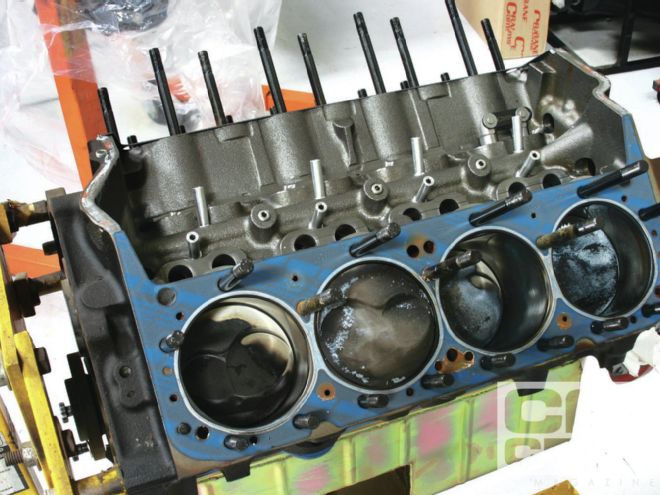
There are very few sounds sweeter to a gearhead than a small-block spinning past 8,000 rpm. For anyone who appreciates internal-combustion engines and horsepower, a race engine spinning at high rpm is hypnotic. But for most street-car enthusiasts, engine speeds above 6,500 rpm (and certainly beyond 7,500) might as well be a bench-racing fantasy. The point of high rpm is power. If the engine can make good torque at a higher engine speed, it will make more horsepower. But in order to reliably achieve those stratospheric engine speeds, conventional wisdom holds that you have to run mechanical roller lifters, monster valvespring pressures, and expensive shaft-mount rocker systems—and those are just the valvetrain pieces. So when the guys at Crane claimed they had a hydraulic roller lifter that would live at 8,000-plus rpm, we were interested. The team of Westech Performance's Steve Brulé and Crane Cams' Chase Knight collaborated to assemble a small-block Chevy that we would spin to 8,500 rpm, just to show that it could be done. And it did—many, many times.
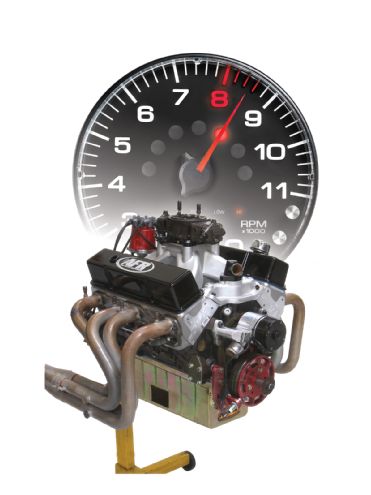 This small-block proved to us that properly designed hydraulic roller lifters could operate and survive at 8,500 rpm.
This small-block proved to us that properly designed hydraulic roller lifters could operate and survive at 8,500 rpm.
This was not a one-trick-pony deal. We didn't just hammer it once and call it good. Steve ran this small-block up on Westech's Superflow 904 dyno multiple times, working his way up from 7,500 to 8,000 and finally to 8,500 rpm. So that's the large-print headline—but the real story is how we got there—and why. That brings us to all the juicy details you'll need to know should you want to duplicate this effort.
Why Go There?
This is the go-to question. Don't we already have entire catalogs of mechanical roller camshafts and stiff springs that will achieve mega rpm? The obvious answer is an unqualified yes. So let's start this discussion with a qualifier that even with a killer 8,500-rpm valvetrain, you still must have an extremely reliable rotating assembly to be able to withstand these engine speeds. This means a high-quality forged crank, forged pistons, and stout connecting rods. Stroke obviously plays a part in this equation, as well, since the G-loads imparted on a piston and rod assembly at a given rpm are directly affected by stroke. A 3.00-inch-stroke 302 small-block Chevy piston travels a much shorter distance than a 4.00-inch stroke small-block at the same engine speed. Therefore, the long-stroke piston must travel much faster and accelerate away from both TDC and BDC much quicker at this same speed. RPM is the great determiner in terms of engine durability. We've grown accustomed to seeing NASCAR small-blocks spin to 9,000-plus rpm on television, but that doesn't mean that your stock small-block will live at those speeds.
Assuming we have an engine that will live and make power at 8,000 rpm, why would you want to go with hydraulic roller lifters as opposed to a mechanical roller? Let's start with the fact that mechanical roller cams all require lash or clearance while running. Long idle periods combined with wide lash specs can cause problems. According to the Bosch Engineering Handbook, needle roller bearings are very impact-load sensitive. This means that constant hammering of the lifter against the cam lobe can cause a flat spot on the tiny roller bearings. Once that happens, it's only a matter of time before the bearing fails. Since mechanical roller cams require a lash setting of somewhere around 0.014 to 0.020 inch, this is an issue. Hydraulic roller lifters, on the other hand, operate with a preload that creates constant contact between the roller lifter and the cam lobe, which (in theory) is an inherent advantage in favor of the hydraulic lifter concept.
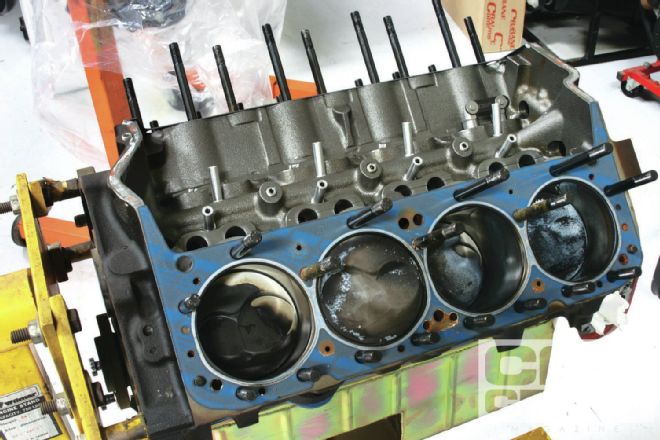 The short-block consists of high-quality components like a Callies crank, Carillo connecting rods, and JE forged, domed pistons. Compression is 13.1:1, so Brulé also included a set of ARP head studs and our favorite Fel-Pro head gaskets to keep the pressure in the cylinders.
The short-block consists of high-quality components like a Callies crank, Carillo connecting rods, and JE forged, domed pistons. Compression is 13.1:1, so Brulé also included a set of ARP head studs and our favorite Fel-Pro head gaskets to keep the pressure in the cylinders.
Keys to RPM
We spoke at length to Chase Knight at Crane Cams about these 8,500-rpm small-block lifters to understand why this system works so well. Knight emphasized that professionally matched components that are proven to work well together is key. Crane has put major research effort into matching valvetrain components that they know will withstand these high-rpm ventures without failure—effectively, a system's approach to the valvetrain. If you are serious about valvetrain development, you either own or have access to a Spintron. This is a machine developed by Bob Fox, which allows valvetrain developers to test components like cam lobe profiles, lifters, valvesprings, retainers, valve locks, pushrods, and rocker arms for durability and compatibility. The key to a successful high-rpm hydraulic roller valvetrain, according to Knight, is a combination of lightweight and high-strength components. An example would be pushrods. This 8,500-rpm hydraulic roller lifter 355ci small-block is stout not just because it was able to achieve a very stable rpm curve. The amazing part is that it did it using street version 5⁄16-, 0.080-inch-wall pushrods and a stud-mounted rocker system. Most professional engine builders would recommend at least a shaft rocker system, along with custom, 3⁄8-inch-diameter pushrods to achieve even greater stiffness.
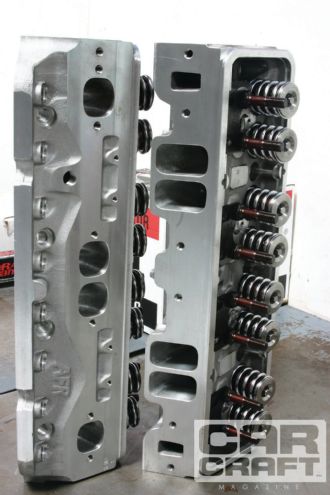 AFR supplied a set of small-block 227cc intake-port heads to help the little 357ci engine make power at this elevated engine speed. These heads have the potential to flow 310-plus cfm even on a relatively small 4.030-inch bore.
AFR supplied a set of small-block 227cc intake-port heads to help the little 357ci engine make power at this elevated engine speed. These heads have the potential to flow 310-plus cfm even on a relatively small 4.030-inch bore.
Of course, not just any hydraulic roller lifter is capable of such performance. Knight says Crane's lifter starts with an 8620 steel body that is heat-treated and carburized to increase the lifter body's surface hardness. Crane also makes all of the lifter's internal components and select-fits these pieces to ensure internal clearances that are measured in microns instead of thousandths of an inch. A micron is 10^-6 meter or 0.000000393 inch. This means that typical bearing clearances where you might measure to 0.0001 aren't nearly precise enough. Knight says measurements for these lifters are magnitudes tighter. Knight also warned, "Hydraulic lifters are the engine's most efficient oil filter," which means that keeping the oil clean will also be of great benefit to maintain the lifter's efficiency. If debris is allowed to contaminate the lifter, the check ball will stick open and allow the lifter to bleed down, which is not good.
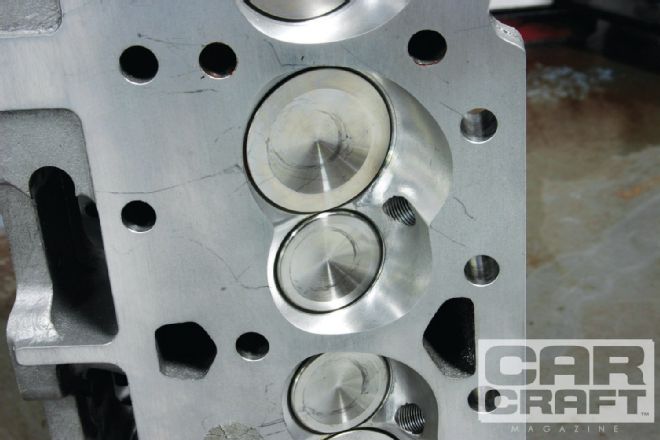 The AFR 227 heads came with a 64cc chamber and 2.100/1.600-inch stainless steel valves using smaller, 8mm (LS engine size) valve stems to reduce weight.
The AFR 227 heads came with a 64cc chamber and 2.100/1.600-inch stainless steel valves using smaller, 8mm (LS engine size) valve stems to reduce weight.
Pump Up, or Pump Down?
So how is it that a hydraulic lifter is capable of controlling a heavy stainless steel intake valve at 8,500 rpm? A commonly held belief is that high valvespring pressure at high engine speeds can push the oil out of the lifter, creating pump-down problems, explaining why hydraulic lifters cannot withstand high engine speeds. Knight says this is possible if the lifter suffers from excessive internal clearances that directly affect the lifter's bleed-down rate. Since the Crane lifter maintains such tight clearances, Knight says that lifter pump-down just doesn't happen. As long as the check ball in the lifter is not unseated by some foreign material, Knight says, the lifter will not bleed down. Our engine testing certainly supports that contention.
The other problem area is the exact opposite of lifter pump-down—the dreaded lifter pump-up. In this case, at some rpm point, valvetrain separation occurs due to a loss of control of the valve by the spring, causing a gap to open between the rocker-arm tip and the top of the valve stem. When this occurs, engine oil pressure forces the small piston upward against the snap ring, eliminating the amount of lifter preload. This could be enough to hold the valve open, which would be instantly followed by a dramatic loss of power. Valvetrain separation occurs most often not through the fault of the lifter but rather either poor valvetrain harmonics or by any number of potential problems, such as flexing pushrods, weak valvesprings, heavy valvetrain components, or perhaps a dozen other potential problems. This again reinforces the point of a systems approach to a high-rpm valvetrain. If the springs, retainers, valves, rocker arms, and pushrods are properly matched, valvetrain separation should be an extremely rare occurrence.
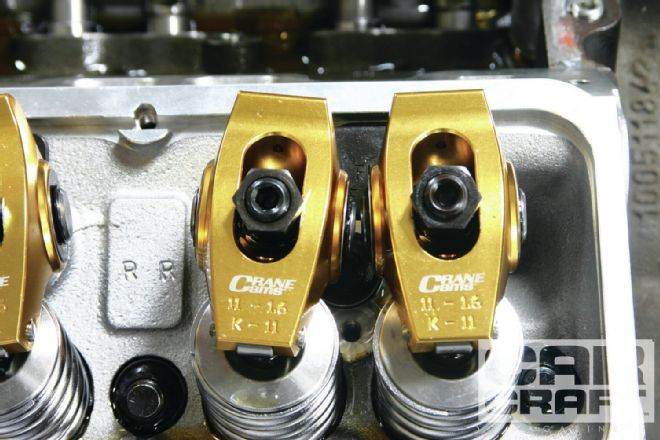 Those are Crane Gold 1.6:1 aluminum widebody roller rocker arms. The AFR heads widen the intake valve spacing to fit a larger valve and recommends an offset rocker arm and adjustable guide plates. For this story, we were able to align the intake rocker, but you can see it is a bit “pigeon-toed.” For street durability, you really should go with an offset rocker. Crane makes a 0.150-inch offset (at the pushrod cup), and you will need four lefts and four rights to make this work properly. Also note this engine did not use a shaft rocker system despite the stratospheric rpm.
Those are Crane Gold 1.6:1 aluminum widebody roller rocker arms. The AFR heads widen the intake valve spacing to fit a larger valve and recommends an offset rocker arm and adjustable guide plates. For this story, we were able to align the intake rocker, but you can see it is a bit “pigeon-toed.” For street durability, you really should go with an offset rocker. Crane makes a 0.150-inch offset (at the pushrod cup), and you will need four lefts and four rights to make this work properly. Also note this engine did not use a shaft rocker system despite the stratospheric rpm.
The Test
With the Westech 355ci small-block assembled, it was time to start twisting up the rpm. Steve decided that rather than go for it all at once, we would begin at 7,000 rpm and work our way up. The pulls at 7,000, 7,500, and 8,000 all went very well, so there was nothing left to do but yank it to 8,250. The curve looked about as perfect as we could ask for, which just begged Steve to try 8,500. The curve that we've reproduced here is not that run, but probably the fifth or sixth run at this rpm. As you can see, the curve looks as smooth as a baby's butt. Needless to say, we were pretty stoked, which prompted a discussion about what a bad curve would look like. Steve pulled up a curve from a big-block Chevy that, just after 5,700 rpm, begins to fall off rather sharply. When viewed by itself, this curve does not look all that bad, but when you compare it to a subsequent run with upgraded valvesprings, you can see just how much power that big-block left on the table. What is perhaps the most surprising is that better valve control was worth 10 to 12 more horsepower below 4,000 rpm. This means the poor Rat motor was suffering almost from the moment the engine started! Then, look at the improvement at 6,100 rpm where superior valve control is worth 33 hp. In our experience, when an engine gets into valvetrain trouble, each time you run the engine up to max power, the rpm point for peak horsepower continues to fall and very soon the engine simply won't rpm past 5,000 rpm because of this lack of control. So now look back at our multiple 8,500-rpm pulls with the hydraulic roller cam, and it makes it all that much more impressive.
Conclusions
Clearly, Crane's lifters when combined with a professionally designed valvetrain will allow you to spin a little small-block Chevy, Ford, or even a Mopar to unheard-of rpm points and make power up there without the need for massive valvesprings and mechanical roller lifters. By reducing valvespring pressure (compared to a mechanical roller cam), the load on the engine is automatically reduced, which immediately means the parts will last longer. If you've ever read any of the day-to-day accounts from Hot Rod's Drag Week™, then you are no-doubt familiar with the valvetrain carnage that the competitors regularly deal with. The daily reports of broken and mangled valvesprings, rocker arms, and pushrods sounds more like the casualty reports from the D-day invasion of Normandy in WWII. Given our experience with Crane's hydraulic roller lifters, you could make a case for converting a high-horsepower, high-rpm mechanical roller package to a hydraulic roller and then sit back and watch your competitors replace valvesprings and mechanical roller lifters while you drink ice tea in the shade.
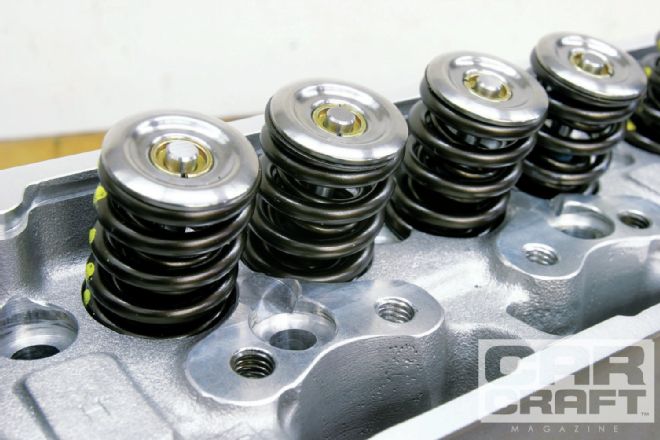 Crane also spec’d the valvesprings, titanium retainers, and 7-degree locks. If you are familiar with mechanical roller valvetrains, these springs are probably closer to what you’d expect for a mechanical roller cam. Titanium retainers reduce weight at the top of the spring, which travels the farthest. This permits the use of a more conservative spring load to enhance durability.
Crane also spec’d the valvesprings, titanium retainers, and 7-degree locks. If you are familiar with mechanical roller valvetrains, these springs are probably closer to what you’d expect for a mechanical roller cam. Titanium retainers reduce weight at the top of the spring, which travels the farthest. This permits the use of a more conservative spring load to enhance durability.
VALVESPRING SPECS PN Spring Dia. Closed Load Open Load Coil Bind Spring Rate 96883-16 1.540 in. 225 lb. at 1.950 in. 570 lb. at 1.300 in 1.130 in. 544 lb./in.
CAM SPECS Cam Duration at 0.050 Valve Lift (inches) Lobe Separation Intake 268 0.640 w/ 1.6:1 108 Exhaust 272 0.640 w/ 1.6:1
PARTS LIST Description PN Source Price AFR 227 heads 1067 BuyAFR.com $3172.34 AFR offset stud girdle 6208 BuyAFR.com 102.96 Crane cam custom Crane Call Crane hydraulic roller lifters 11532-16 Summit Racing 696 Crane springs, dual 96883-16 Summit Racing 340.80 Crane valve retainers 99659-16 Summit Racing 355.20 Crane valve locks 99107-1 Summit Racing 48 Crane spring locators 99460-16 Summit Racing 72 Crane alum. rocker arms 11772-16 Summit Racing 456 Crane offset rockers 1.6:1 left 11765L-1 Summit Racing 33.40 (ea.) Crane offset rockers 1.6:1 right 11765R-1 Summit Racing 33.40 (ea.) Crane pushrods 95623 Summit Racing 156.80 Edelbrock Super Victor II 2892 Summit Racing 379.97 JE pistons 182012-8 Summit Racing 782.96 Holley 950 Ultra HP carb 0-80805HB Summit Racing 822.97 Milodon oil pan 31065 Summit Racing 359.97 Milodon oil pump 18750 Summit Racing 41.97 Milodon oil pickup 18314 Summit Racing 43.97 Milodon oil pump shaft 23050 Summit Racing 16.97 Edelbrock Super Victor II 2892 Summit Racing 379.97 ATI balancer 917020 Summit Racing 279.80 MSD crank trigger 8615 Summit Racing 255.97 MSD distributor 85501 Summit Racing 259.97 MSD spark plug wires 31223 Summit Racing 84.97 ARP head studs 234-4301 Summit Racing 224.08 ARP crank bolt 134-2501 Summit Racing 23.59 ARP intake bolt 134-2001 Summit Racing 19.90 Fel-Pro head gasket 1010 Summit Racing 38.97 Fel-Pro oil pan gasket 1818 Summit Racing 12.97 Fel-Pro intake gasket 1206 Summit Racing 14.97 Fel-Pro valve cover gasket 1628 Summit Racing 50.97
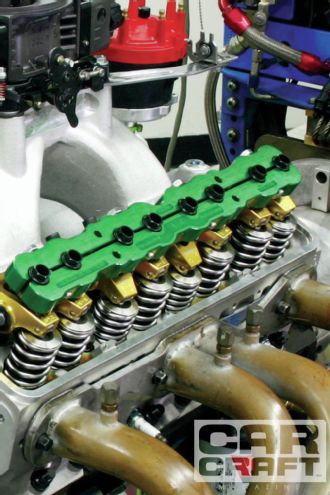 In search of additional valvetrain stability, Brulé included an AFR rocker stud girdle assembly. Crane also sells girdles for small-block Chevys, but because of valve spacing, these heads require a specific AFR girdle.
In search of additional valvetrain stability, Brulé included an AFR rocker stud girdle assembly. Crane also sells girdles for small-block Chevys, but because of valve spacing, these heads require a specific AFR girdle.
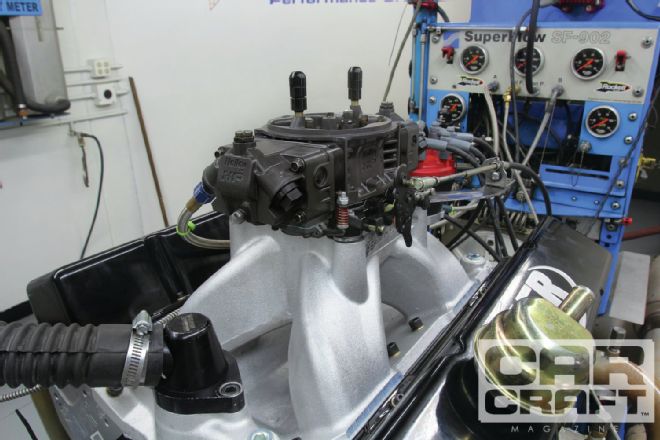 For a carburetor, we went with a Holley 950-cfm Ultra HP running Rockett race gas, while the ignition is an MSD CD package with a crank trigger for timing accuracy. Those little caps on the carb vent tubes are safety items designed to prevent fuel spillage during a rollover.
For a carburetor, we went with a Holley 950-cfm Ultra HP running Rockett race gas, while the ignition is an MSD CD package with a crank trigger for timing accuracy. Those little caps on the carb vent tubes are safety items designed to prevent fuel spillage during a rollover.